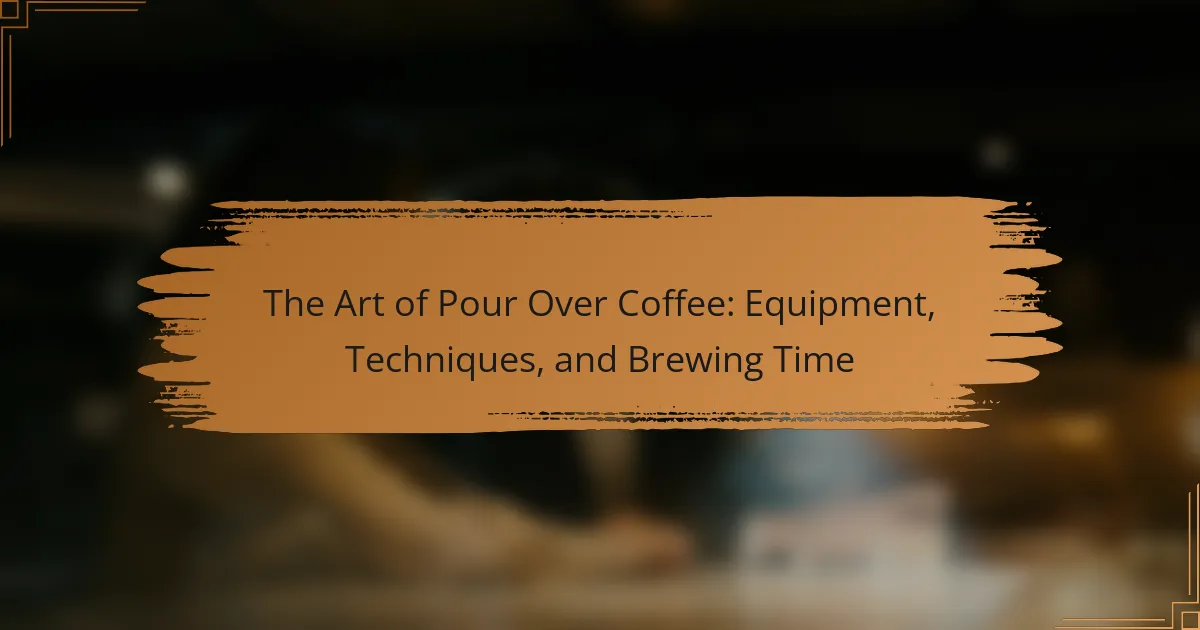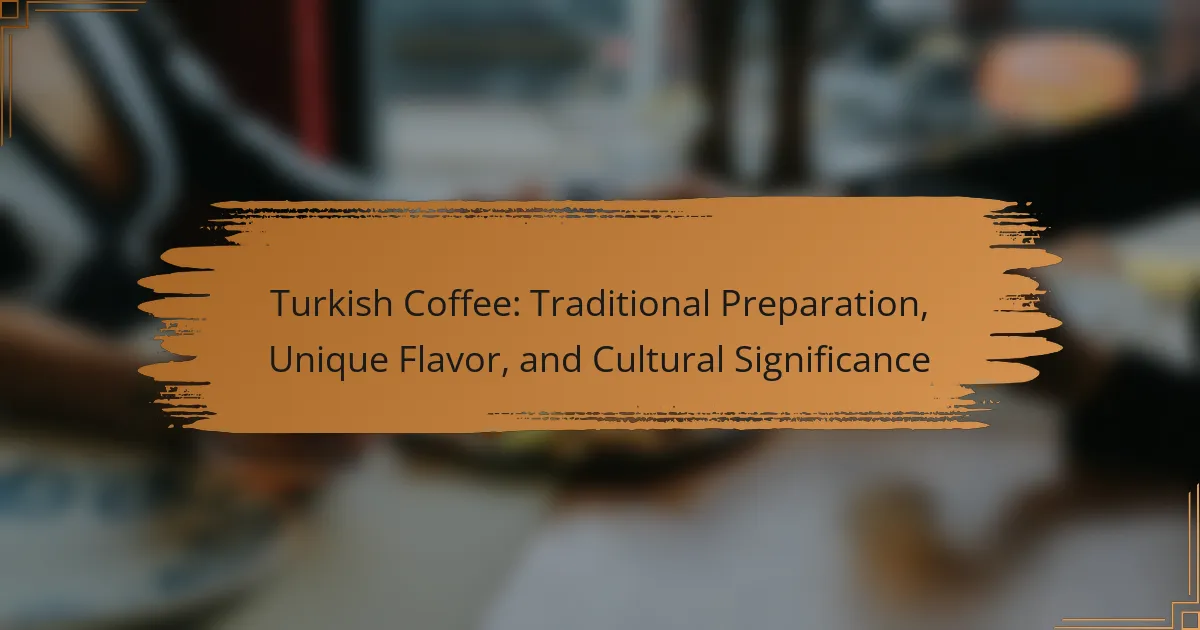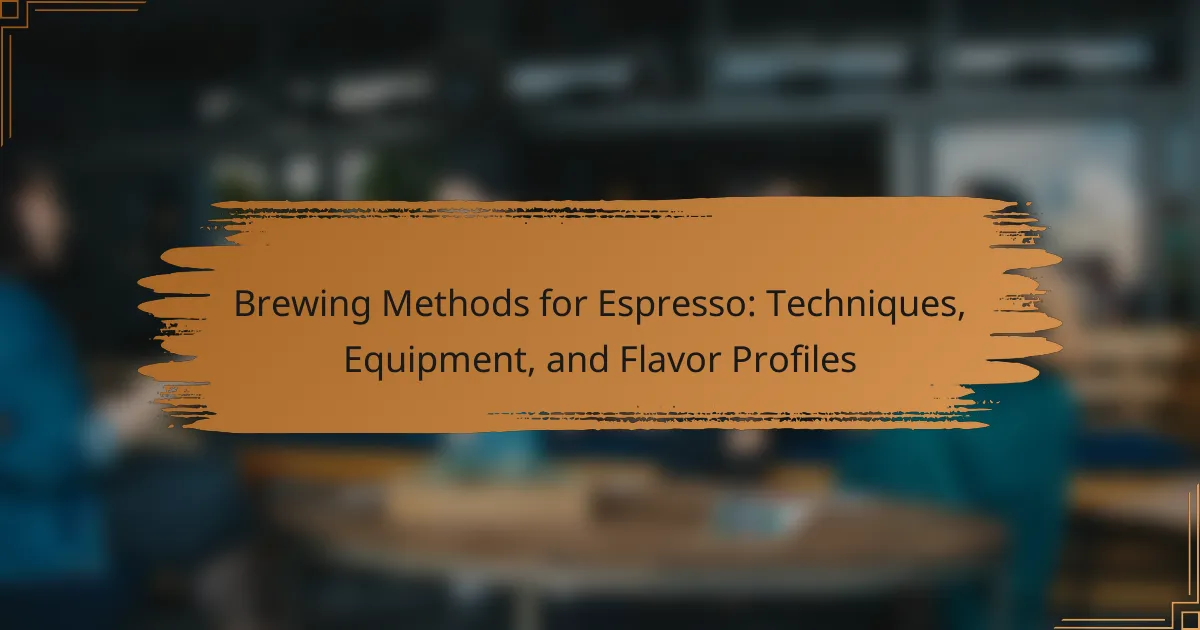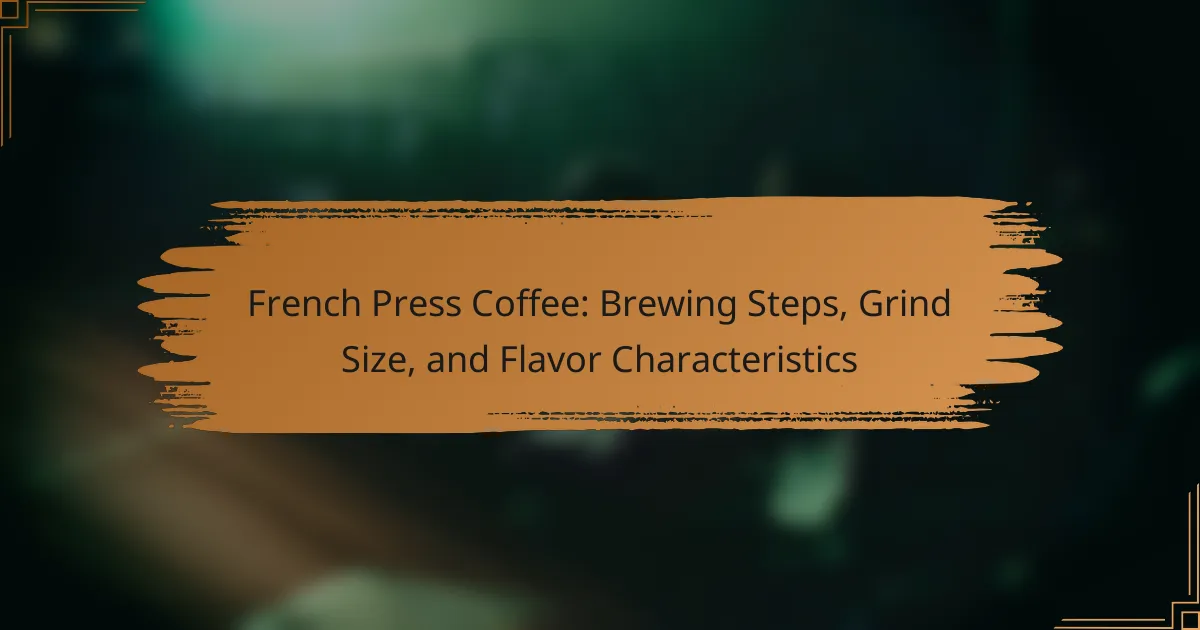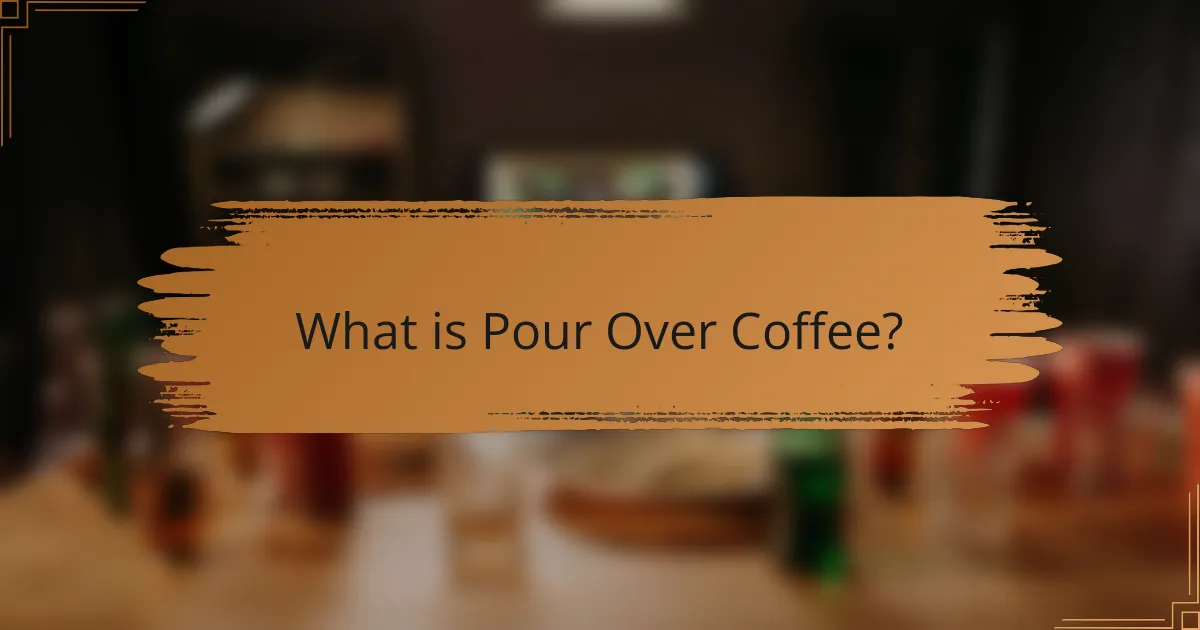
What is Pour Over Coffee?
Pour over coffee is a manual brewing method where hot water is poured over coffee grounds. This technique allows for precise control over the brewing process. The water extracts flavors from the coffee grounds as it flows through them. The brewed coffee then drips into a container below. Pour over coffee is known for its clean and bright flavor profile. Many coffee enthusiasts prefer this method for its ability to highlight specific coffee characteristics. It requires specific equipment, such as a pour over cone and filter. This method has gained popularity in specialty coffee circles for its artisanal approach.
How does the pour over coffee brewing method work?
The pour over coffee brewing method works by manually pouring hot water over coffee grounds. This process allows for precise control over brewing time and water temperature. A filter holds the coffee grounds in place while the water extracts flavors. The brewed coffee then drips into a carafe or cup below.
Key components include a pour over dripper, filter, and kettle. The dripper can be made of various materials, such as ceramic or plastic. Water should be at a temperature between 195°F and 205°F for optimal extraction. The coffee-to-water ratio typically ranges from 1:15 to 1:17.
Pour over brewing emphasizes clarity and brightness in flavor profiles. This method is often favored for its ability to highlight the unique characteristics of different coffee beans. The technique has gained popularity among coffee enthusiasts for its simplicity and effectiveness.
What are the essential components of the pour over coffee setup?
The essential components of the pour over coffee setup include a pour over brewer, a coffee filter, freshly ground coffee, a kettle, and a scale. The pour over brewer is typically made of ceramic, glass, or plastic and allows for controlled brewing. A coffee filter is required to separate the grounds from the brewed coffee. Freshly ground coffee enhances flavor and aroma. A kettle, preferably with a gooseneck spout, provides precision in pouring water. Finally, a scale ensures accurate measurement of coffee and water for consistency. These components work together to create a quality pour over coffee experience.
How does water temperature affect the extraction process in pour over coffee?
Water temperature significantly affects the extraction process in pour over coffee. Higher temperatures increase the solubility of coffee compounds. This leads to faster extraction of flavors and aromas. Ideal brewing temperatures range from 195°F to 205°F. At these temperatures, optimal extraction occurs without over-extraction. Over-extraction can result in bitter flavors. Conversely, lower temperatures can lead to under-extraction. Under-extracted coffee often tastes sour or weak. Studies indicate that temperature impacts the balance of acidity and sweetness in the final cup.
What are the benefits of brewing coffee using the pour over method?
Brewing coffee using the pour over method offers several benefits. This technique allows for greater control over the brewing process. Users can adjust variables such as water temperature and pour rate. This results in a more customized flavor profile. The pour over method enhances the extraction of coffee oils and flavors. Studies show that this method can produce a cleaner cup of coffee. The process also minimizes sediment compared to other brewing methods. Additionally, it encourages mindful brewing, enhancing the overall coffee experience. These factors contribute to a richer, more enjoyable cup of coffee.
How does pour over coffee enhance flavor compared to other brewing methods?
Pour over coffee enhances flavor by allowing precise control over the brewing process. This method involves a slow, steady pour that saturates the coffee grounds evenly. The even saturation extracts flavors more effectively than methods like drip brewing. It highlights the coffee’s unique characteristics better due to the ability to adjust variables like water temperature and pour rate. Studies show that pour over can produce a cleaner cup with more pronounced flavor notes. This is because it minimizes sediment and allows for better extraction of aromatic compounds. The result is a more vibrant and nuanced flavor profile compared to other brewing techniques.
What control does the pour over method offer to the brewer?
The pour over method offers precise control over brewing variables. Brewers can manipulate water temperature, flow rate, and brew time. This method allows for consistent extraction of flavors. Adjusting these factors can enhance the coffee’s taste profile. For instance, a slower pour can lead to fuller extraction. Conversely, a faster pour may produce a lighter flavor. The ability to experiment with grind size also contributes to control. Each of these elements can be tailored to the brewer’s preference.

What equipment is needed for pour over coffee?
To make pour over coffee, you need a few essential pieces of equipment. First, a pour over coffee maker is required. This can be a dripper like a V60 or Chemex. Second, you need a coffee grinder to grind fresh coffee beans. A burr grinder is recommended for consistency. Third, a kettle is necessary for boiling water. A gooseneck kettle allows for precise pouring. Fourth, filters are needed to catch the coffee grounds. Lastly, a scale is useful for measuring coffee and water accurately. These items are crucial for creating a quality pour over coffee.
What types of pour over coffee makers are available?
There are several types of pour over coffee makers available. Common types include manual pour over cones, electric pour over brewers, and immersion brewers. Manual pour over cones, such as the Hario V60 and Chemex, require users to control the pouring technique. Electric pour over brewers, like the Bonavita and Technivorm, automate the brewing process for consistency. Immersion brewers, such as the Clever Dripper, combine steeping and pouring methods. Each type offers distinct brewing experiences and flavor profiles.
How do different pour over coffee makers compare in terms of functionality?
Different pour over coffee makers vary in functionality based on design and brewing method. Common types include the Chemex, Hario V60, and Kalita Wave. The Chemex utilizes a thick paper filter, producing a clean cup with bright flavors. The Hario V60 features a cone shape that allows for variable flow rates, enabling control over extraction. The Kalita Wave has a flat-bottom design, promoting even extraction and reducing the risk of channeling.
Functionality also varies in terms of ease of use and maintenance. The Chemex is straightforward but requires specific filters. The Hario V60 is versatile but demands more skill. The Kalita Wave is user-friendly, making it ideal for beginners. Each maker’s design influences the brewing process and the resulting flavor profile. Overall, choosing a pour over coffee maker depends on personal preference and desired coffee characteristics.
What accessories are essential for a successful pour over experience?
Essential accessories for a successful pour over experience include a pour over brewer, a gooseneck kettle, and a coffee scale. The pour over brewer allows for optimal extraction of coffee flavors. A gooseneck kettle provides precise control over water flow and temperature. A coffee scale ensures accurate measurement of coffee grounds and water. Additionally, using a filter is necessary to separate coffee from grounds. A timer is helpful for tracking brewing time. These accessories enhance the overall quality of the pour over process. Each accessory contributes to a more controlled and flavorful cup of coffee.
How do you choose the right coffee grinder for pour over brewing?
Choose a burr grinder for pour over brewing. Burr grinders provide a consistent grind size, essential for optimal extraction. Consistency in grind size leads to better flavor and aroma. Look for grinders with adjustable settings to customize grind coarseness. A coarser grind is recommended for pour over methods. The grind size impacts water flow and extraction time. Aim for a grind size similar to sea salt for pour over. Quality burr grinders are available at various price points, ensuring accessibility.
What grind size is optimal for pour over coffee?
The optimal grind size for pour over coffee is medium to medium-fine. This grind size allows for balanced extraction during the brewing process. A medium grind increases the surface area, facilitating better water flow. Medium-fine grinds slow down the extraction slightly, preventing over-extraction. Research indicates that a grind size between 200 to 300 microns works best for pour over methods. This range ensures a consistent brew with desirable flavor profiles. Thus, using a medium to medium-fine grind size is essential for achieving the best results in pour over coffee.
How does grind consistency impact the final cup of pour over coffee?
Grind consistency significantly impacts the final cup of pour over coffee. Uniform grind size allows for even extraction during brewing. This results in balanced flavors and aroma. Inconsistent grind sizes can lead to over-extraction or under-extraction. Over-extraction produces bitter flavors, while under-extraction results in sour notes. Studies show that grind size affects extraction rates and flavor profiles. For instance, a study by the Specialty Coffee Association highlights the importance of grind uniformity in achieving optimal flavor. Therefore, maintaining grind consistency is crucial for a desirable pour over coffee experience.
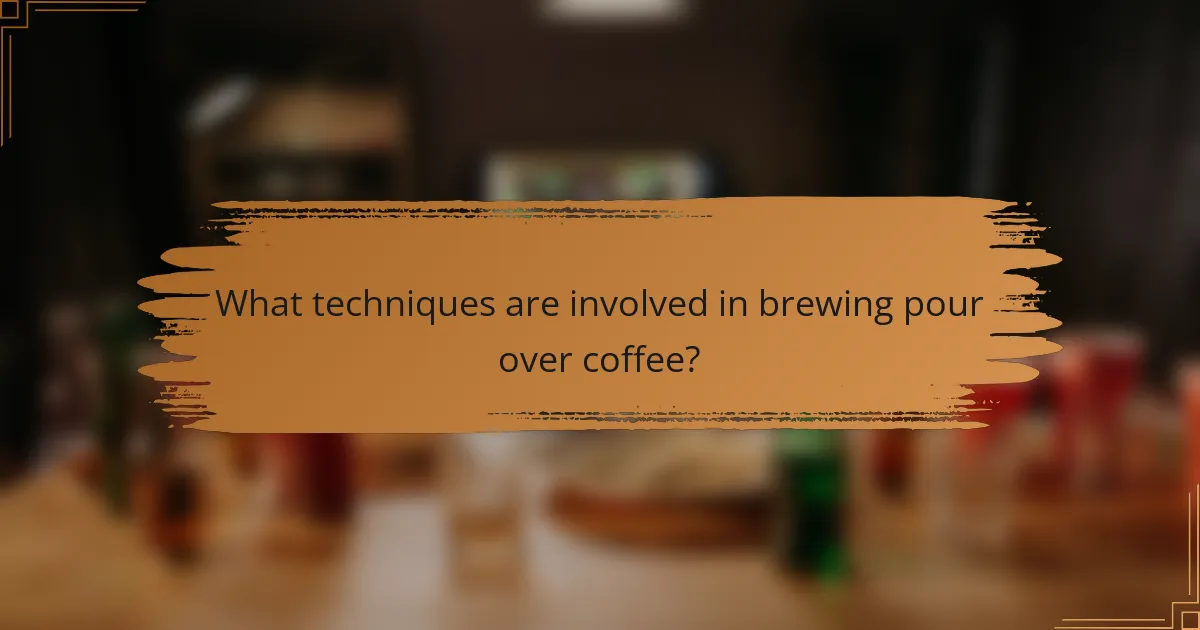
What techniques are involved in brewing pour over coffee?
Pour over coffee brewing involves several key techniques. First, the grind size of coffee beans should be medium to fine. This allows for optimal extraction during the brewing process. Second, pre-wet the coffee filter to eliminate paper taste and help the coffee flow smoothly. Third, the water temperature should be between 195°F and 205°F for ideal extraction. Fourth, pour water in a circular motion to evenly saturate the coffee grounds. This technique promotes uniform extraction and enhances flavor. Fifth, bloom the coffee by adding a small amount of water first, allowing gases to escape. This step improves flavor clarity. Lastly, control the pouring rate to adjust brew time, typically between two to four minutes for optimal flavor extraction. These techniques collectively enhance the quality and taste of pour over coffee.
How do you properly measure coffee and water for pour over brewing?
To properly measure coffee and water for pour over brewing, use a coffee-to-water ratio of 1:15. This means for every gram of coffee, use 15 grams of water. For example, if you use 20 grams of coffee, you should use 300 grams of water. Measuring by weight ensures accuracy and consistency in flavor. Use a digital scale for precision. Place your coffee grounds in the filter and tare the scale to zero. Gradually pour the water over the coffee grounds in a circular motion. This technique promotes even extraction. Aim for a total brew time of about 3 to 4 minutes for optimal results.
What is the recommended coffee-to-water ratio for pour over coffee?
The recommended coffee-to-water ratio for pour over coffee is typically 1:15 to 1:17. This means for every gram of coffee, you should use 15 to 17 grams of water. A common starting point is 1:16. This ratio balances flavor extraction and strength. Using this ratio helps achieve a well-rounded cup. Adjustments can be made based on personal taste preferences. For instance, a stronger brew may use a 1:15 ratio. Conversely, a milder cup may prefer a 1:17 ratio. This guideline is widely supported by coffee brewing experts.
How does the weight of coffee affect the brewing process?
The weight of coffee significantly impacts the brewing process. It determines the coffee-to-water ratio, which affects flavor extraction. A higher weight of coffee generally leads to a stronger brew. Conversely, less coffee results in a milder taste.
For optimal extraction, a common ratio is 1:15 coffee to water. This means for every gram of coffee, 15 grams of water is used. Adjusting the weight alters the brew’s strength and flavor profile.
Research shows that using 20 grams of coffee with 300 grams of water yields a balanced flavor. The brewing time can also be influenced by the weight of coffee. More coffee may require longer brewing to extract flavors fully.
Therefore, understanding the weight of coffee is crucial for achieving desired taste and strength in pour-over brewing.
What pouring techniques can enhance the brewing process?
Pouring techniques that enhance the brewing process include the spiral pour, bloom pour, and pulse pour. The spiral pour involves pouring water in a circular motion to evenly saturate the coffee grounds. This technique promotes uniform extraction, leading to a balanced flavor profile. The bloom pour allows coffee to degas by initially pouring a small amount of water over the grounds, letting it sit for 30 seconds before continuing. This enhances flavor extraction by allowing gases to escape. The pulse pour consists of pouring water in intervals, allowing the coffee to absorb water gradually. This method helps control the brewing time and extraction rate, resulting in a richer taste. Each technique can significantly impact the final cup’s quality and flavor.
What is the significance of the bloom phase in pour over coffee?
The bloom phase in pour over coffee is significant because it allows for the release of carbon dioxide from freshly ground coffee. This release enhances the extraction of flavors during brewing. During the bloom, hot water is poured over the coffee grounds, causing them to swell and release gas. This process typically lasts 30 to 45 seconds. Proper blooming results in a more balanced and flavorful cup of coffee. Studies show that skipping the bloom can lead to under-extraction and a less aromatic brew. Therefore, the bloom phase is essential for optimal flavor development in pour over coffee.
How can pouring speed and pattern influence extraction?
Pouring speed and pattern significantly influence coffee extraction during the pour-over process. A faster pouring speed can lead to uneven extraction, as water may not have enough time to saturate the coffee grounds fully. This can result in under-extraction, where desirable flavors are not fully extracted. Conversely, a slow pouring speed allows for better saturation and extraction, enhancing flavor complexity.
The pouring pattern also plays a crucial role. A spiral pattern can help ensure even coverage of the coffee bed, promoting uniform extraction. In contrast, a concentrated pouring pattern may lead to channeling, where water flows through specific paths, causing uneven extraction. Research indicates that optimal pouring techniques can improve flavor profiles in brewed coffee. For example, a study by the Specialty Coffee Association found that controlled pouring methods can enhance the overall taste and aroma of the coffee.
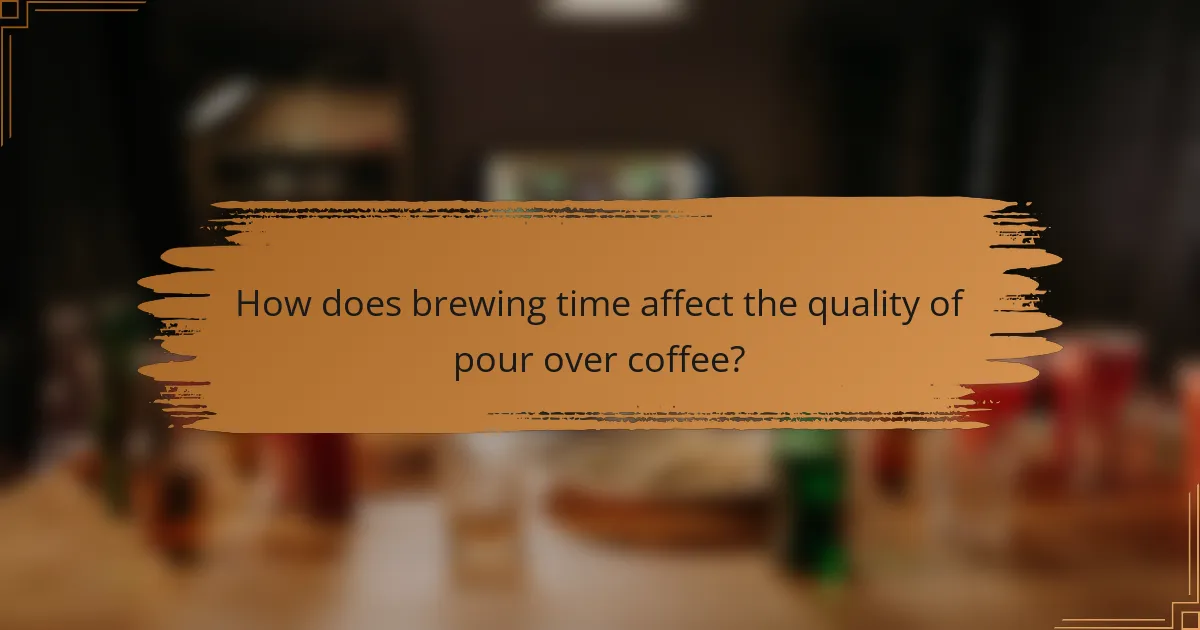
How does brewing time affect the quality of pour over coffee?
Brewing time significantly affects the quality of pour over coffee. Optimal brewing time typically ranges from 2.5 to 4 minutes. Shorter brewing times may result in under-extraction. Under-extracted coffee often tastes sour and lacks depth. Conversely, longer brewing times can lead to over-extraction. Over-extracted coffee tends to taste bitter and harsh. The balance of flavors is crucial for a satisfying cup. Studies show that brewing within the optimal time frame enhances flavor clarity and body. Proper timing allows for the extraction of desirable compounds while minimizing undesirable ones.
What is the ideal brewing time for pour over coffee?
The ideal brewing time for pour over coffee is between 2.5 to 4 minutes. This time frame allows for optimal extraction of flavors from the coffee grounds. During this process, water should flow evenly through the coffee bed. A brewing time of 3 minutes is often recommended for a balanced cup. Factors such as grind size and coffee-to-water ratio can influence this time. For example, a finer grind may require a shorter brewing time. Conversely, a coarser grind may need a longer time for proper extraction. Studies indicate that brewing within this range maximizes flavor without over-extraction.
How does brewing time correlate with coffee strength and flavor?
Brewing time directly influences coffee strength and flavor. Longer brewing times typically extract more soluble compounds from coffee grounds. This increased extraction leads to a stronger coffee taste. Conversely, shorter brewing times may result in a milder flavor. Research shows that optimal brewing times range from 2 to 4 minutes for pour-over methods. During this period, essential oils and acids are released, enhancing flavor complexity. Over-extraction can cause bitterness, while under-extraction leads to sourness. Therefore, adjusting brewing time is crucial for achieving the desired coffee profile.
What common mistakes should be avoided during pour over brewing?
Common mistakes to avoid during pour over brewing include using incorrect grind size, improper water temperature, and inadequate blooming. A grind size that is too coarse leads to under-extraction. Conversely, a grind that is too fine can cause over-extraction and bitterness. Water temperature should ideally be between 195°F and 205°F. Using water that is too hot can scorch the coffee, while water that is too cold can result in weak flavors. Failing to bloom the coffee for 30-45 seconds can hinder flavor extraction. Additionally, pouring water too quickly can lead to uneven saturation. Not using a scale to measure coffee and water can result in inconsistent brews. Lastly, neglecting to clean equipment regularly can affect the taste of the coffee.
How can incorrect brewing time affect the taste of the coffee?
Incorrect brewing time can significantly alter the taste of coffee. Under-brewing leads to a sour, weak flavor. This occurs because not enough soluble compounds are extracted. Over-brewing results in a bitter, astringent taste. This happens due to excessive extraction of undesirable compounds. Ideal brewing time for pour over coffee typically ranges from 2.5 to 4 minutes. Deviating from this range can disrupt the balance of flavors. Research indicates that brewing time directly influences the extraction of acids and oils, which are vital for taste. Accurate timing is essential for achieving the desired flavor profile.
What troubleshooting tips can help improve pour over coffee quality?
Use a consistent grind size for your coffee beans. A medium grind is typically best for pour over. Adjust the water temperature to between 195°F and 205°F for optimal extraction. Ensure you are using the right coffee-to-water ratio, generally 1:15 for pour over. Pre-wet the coffee filter to eliminate paper taste and improve flow. Pour water in a slow, circular motion to evenly saturate the grounds. Allow the coffee to bloom for 30 seconds before the full pour. Experiment with brew time, aiming for a total of 3 to 4 minutes for the best flavor extraction.
Pour over coffee is a manual brewing method that emphasizes precision and control, resulting in a clean and bright flavor profile. This article covers essential equipment needed for pour over coffee, including brewers, filters, kettles, and scales, as well as techniques for optimal brewing, such as grind size, water temperature, and pouring methods. It also addresses the significance of brewing time, common mistakes to avoid, and troubleshooting tips to enhance the quality of the final cup. Readers will gain a comprehensive understanding of the pour over process, from setup to execution, ensuring an enjoyable coffee experience.
